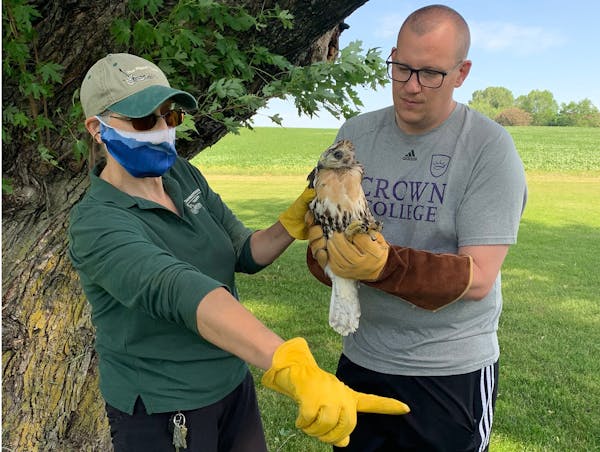ON THE MISSISSIPPI RIVER – From Winona north to the Twin Cities and farther north still to its headwaters in Itasca State Park, this river bends like an artery through Minnesota, and is forever in motion.
Whether bracketed by statuesque pines near Brainerd, the bright lights of the Twin Cities or Wabasha's leafy hardwoods, the Mississippi's one constant is beauty, and never more so than at night.
Steering his custom-made bowfishing boat upstream toward St. Paul, Carl Sassen is afloat in the dark, and comfortably so.
Certain as he is that Minnesotans who fish with hooks and lines love their sport, most, he knows, are by now turning on the 10 o'clock news or are already tucked in bed.
Whereas for Sassen, of Lino Lakes, and his fishing partner, Patrick Kirschbaum of Rogers, the night is just beginning.
"We like to shoot ugly fish,'' Kirschbaum says. "Or, put another way, under-utilized fish.''
In Mark Twain's "Adventures of Huckleberry Finn,'' the Mississippi represents many things to Huck and his pal Jim. But mostly its wide, muddy expanse is a means of escape, and the river serves that purpose no less now than it did when Twain published his novel in 1884.
Guiding his 20-foot-long craft into water only a couple of feet deep, Sassen cuts its big outboard, grabs a bow and arrow and ambles nimbly to the foredeck. Kirschbaum is already there, and is similarly outfitted.
Clear and still, the night belongs not only to Sassen and Kirschbaum but to the mallards that spring noisily from nearby rushes, the blue heron whose fragile legs support its slender silhouette, and the wheels of distant rail cars that clang up and down the riverway.
The setting recalls young Huck's description of life on the Mississippi.
Sometimes we'd have that whole river all to ourselves for the longest time. Yonder was the banks and the islands, across the water; and maybe a spark — which was a candle in a cabin window — and sometimes on the water you could see a spark or two — on a raft or a scow, you know; and maybe you could hear a fiddle or a song coming over from one of them crafts. It's lovely to live on a raft.
With its 8-foot beam, Sassen's boat is more than a raft, and he cranks two generators to life that in turn spark long banks of high-pressure sodium flood lamps that cling to the craft's outer freeboards.
Instantly the shallow water, and everything that swims or crawls in it, is illuminated as the archers and their boat glide slowly ahead. A gimbaled propeller, or fan, spinning from the boat's stern, provides momentum.
"There!''
Opalescent in the manner of cream congealing in water, the brightly lit but cloudy river reveals a target inhabitant, a male dogfish whose spotted tale divulges its gender.
In motions undivided even by split seconds, Kirschbaum identifies the fish, draws back his bow and looses an arrow, which is attached by a string to a fishing reel mounted on the bow.
Surprised but unscathed, the fish as instantly darts into darker water, where it is safe.
Hitting fish with an arrow requires a little luck and a lot of precise calculation, because the fish is not where the bowfisherman's brain thinks it is.
Refracting in water, the boat's lights create an illusion that, uncorrected for, will result in the archer consistently shooting over his objective. The degree of refraction, by turns, varies with the water depth.
In 2009, Sassen and Kirschbaum supported the Minnesota Legislature's decision to allow nighttime bowfishing statewide. Lawmakers acted in part because bowfishermen are modern-day bounty hunters whose "Most Wanted" list is topped by the common carp, which by consensus is the scourge of all things good and beautiful.
Using their pernicious snouts, carp muddy lakes and rivers, preventing the aquatic-plant growth that supports ducks and other wildlife, as well as more desirable fish species.
Yet even carp are smarter than legislators.
"What happened,'' Sassen says, "is that so many people took up the sport after the 2009 law was passed that carp now often scatter rather than stay still when they see our lights coming.''
"We've trained them,'' Kirschbaum says.
Soon another dogfish is spotted, and another and another. Some are impaled and at the outing's end will rest in a farmer's field as fertilizer.
Occasionally also a carp lumbers away in advance of our arrival, the river's undulating surface telltale of the desperado's getaway.
On nights when Sassen and Kirshbaum compete in bowfishing tournaments, they won't quit until the sun comes up. Excursions that they and increasing numbers of other Minnesota bowfishermen make to lakes and rivers in states as far away as Texas are similarly all-night affairs.
The common attraction of each, as it was to Huck and Jim, is water.
So, in two seconds, away we went, a sliding down the river, and it did seem so good to be free again and all by ourselves on the big river and nobody to bother us.
dennis.anderson@startribune.com

Anderson: Celebrate Earth Day by rekindling real connection to nature
Anderson: Anglers protesting tough new Mille Lacs rules are wrong

Anderson: Courts, not politicians, should rule on Red Lake, White Earth lands

Anderson: Multimillion windfall gets invasive carp deterrent moving
![A young whitetail deer searches for food as another blanket of snow coats the arrowhead. ] Minnesota -State of Wonders, Arrowhead in Winter BRIAN PETE](https://arc.stimg.co/startribunemedia/WK32UWWY6FKNWJUIYCJ6ZPT4AU.jpg?h=91&w=145&fit=crop&bg=999&crop=faces)




